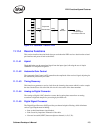
204 Software Developer’s Manual
PHY Functionality and Features
• Far-end crosstalk (FEXT)
• Propagation delay variations between channels of up to 120 ns.
• Extraneous tones that have been coupled into the receive path.
The adaptive filter coefficients are initially set during the training phase. They are continuously
adjusted (adaptive equalization) during operation through the decision-feedback loop.
11.11.4.6 Descrambler
The descrambler identifies each channel by its characteristic signature, removing the signature and
re-routing the channel internally. In this way, the receiver can correct for channel swaps and
polarity reversals. The descrambler uses the same base LFSR used by the transmitter on the other
side of the link.
The descrambler requires approximately 15
s. to lock, normally accomplished during the training
phase.
11.11.4.7 Viterbi Decoder/Decision Feedback Equalizer (DFE)
The Viterbi decoder generates clean 4DPAM5 symbols from the output of the DSP. The decoder
includes a Trellis encoder identical to the one used by the transmitter. The Viterbi decoder simulta-
neously looks at the received data over several baud periods. For each baud period, it predicts
whether the symbol received should be even or odd, and compares that to the actual symbol
received. The 4DPAM5 code is organized in such a way that a single level error on any channel
changes an even code to an odd one and vice versa. In this way, the Viterbi decoder can detect
single-level coding errors, effectively improving the Signal-To-Noise (SNR). When an error
occurs, this information is quickly fed back into the equalizer to prevent future errors.
11.11.4.8 4DPAM5 Decoder
The 4DPAM5 decoder generates 8B data from the output of the Viterbi decoder.
11.12 100 Mbps Operation
The MAC passes data to the PHY over the MII. The PHY encodes and scrambles the data, then
transmits it using MLT-3 for 100TX over copper. The PHY descrambles and decodes MLT-3 data
received from the network. When the MAC is not actively transmitting data, the PHY sends out
idle symbols on the line.
11.13 10 Mbps Operation
The PHY operates as a standard 10 Mbps transceiver. Data transmitted by the MAC as 4-bit nibbles
is serialized, Manchester-encoded, and transmitted on the MDI[0]+/- outputs. Received data is
decoded, de-serialized into 4-bit nibbles and passed to the MAC across the internal MII. The PHY
supports all the standard 10 Mbps functions.


















